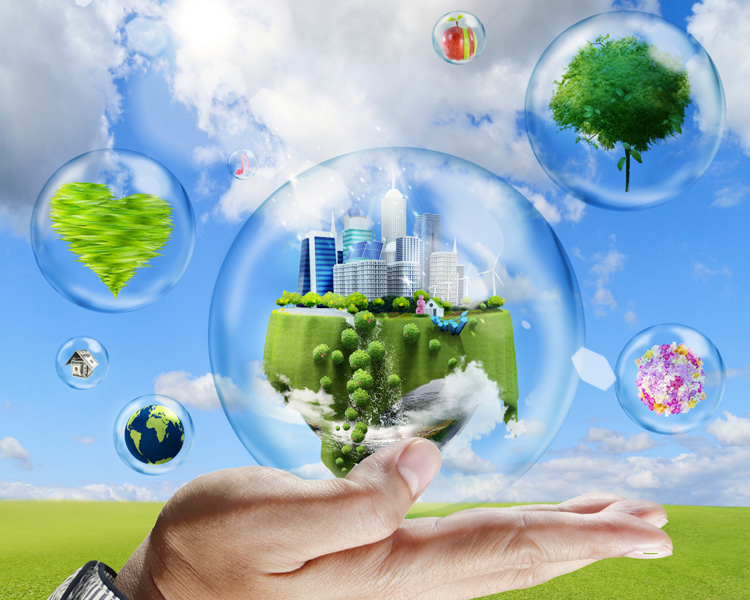
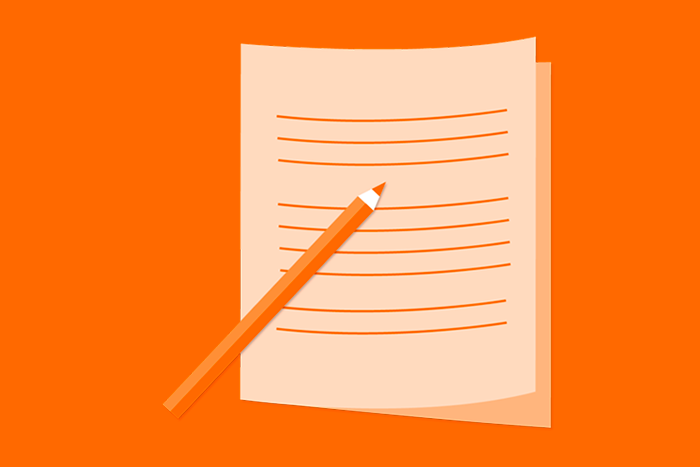
Viewpoints
Viewpoints is a blog in which different writers express their views and opinions on current topics. A new blog post is published about once every four weeks.
You can propose texts by e-mail to viestinta@kesko.fi. The maximum text length is 2,000 characters.
Armi Temmes: Responsibility through innovation
Saving natural resources in the value chain starts from considering the product’s use in the first place. The need may remain while the products change. Landline telephones and films have disappeared, and so will also light bulbs soon. New products also change business models; some examples are given below.
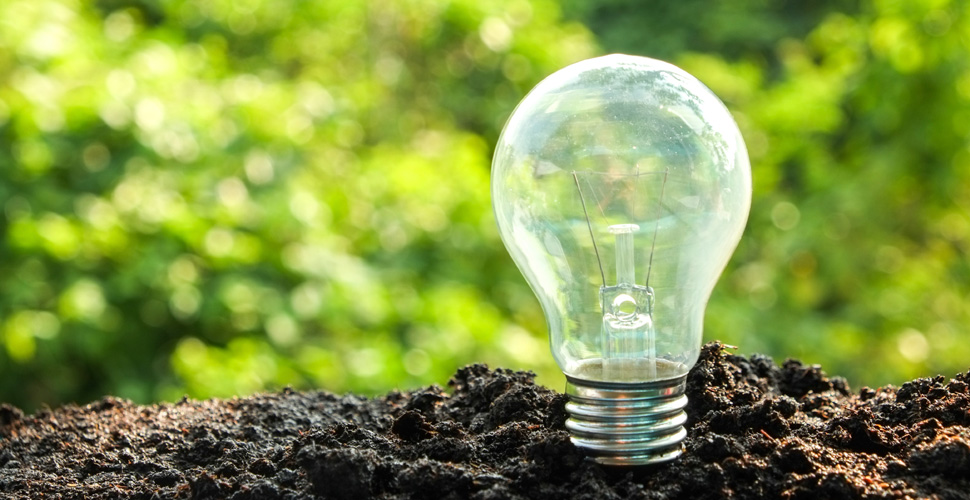
Services generate net sales without natural resources A service provided also helps understand customers’ real needs. Service and maintenance of lifts account for about half of Kone’s net sales, while also providing information on how the company’s lifts are working. Sometimes a product is completely replaced by a service and the user is not interested in what kind of device does the job. The professional use of equipment also generates savings compared to their use at home. The consumption of water, energy and detergent, for example, is low in laundries.
In the circular economy, the ideal is a waste-free society
In addition to flea markets, the circular economy has also generated business. Car and machine components are reprocessed; a fixed gearbox that is nearly as good as new may be available at a lower price and faster than a new one. There is also repaired second hand furniture on sale. A good market for repaired products also promotes the sales of original ones.
In the sharing economy, you don’t need to own everything
The most important thing is that the product is available for use whenever needed. Web applications help us do increasingly what people living in country villages used to do. We borrow things that we need only occasionally − home tools, hobby equipment or vehicles − from our neighbours. A variety of small firms have been set up to create trading sites.
Innovators are hecklers
At the turn of the millennium, editors who were working to develop an online newspaper and tried to arouse enthusiasm among their colleagues were met with harsh comments:”Go away, we have to finish this proper paper”. Now these weird types represent the growing mainstream. Innovators also propose things that current customers have not yet realized they might want. As electronic memory systems emerged, the companies that relied on their major customers’ wishes in development work lost the game along with these customers.
In the changing world, the existing operators have to be alert so as not to lose their positions. Let’s just allow innovators create disturbance in the area of responsibility. It pays off in the long run.
Armi Temmes is Professor of Practice, at Aalto University, School of Economics, after a long career in industry. She has always been enthusiastic about working at the interface of research and practice. The current research focuses on innovations that save energy and natural resources. She teaches sustainable development in business both as an introduction to all students and to those specialising in sustainable development .
Anna Munsterhjelm: Guiding and scouting always offers challenging roles
”Hi! Would you like to buy the advent calendar of the Guides and Scouts of Finland? All proceeds go to guiding and scouting activities!”
There are not many Finns who have not heard these words at some time or other. We know that Christmas is around the corner when young and also a little older scouts appear at street corners, store entrances and our doors selling advent calendars.
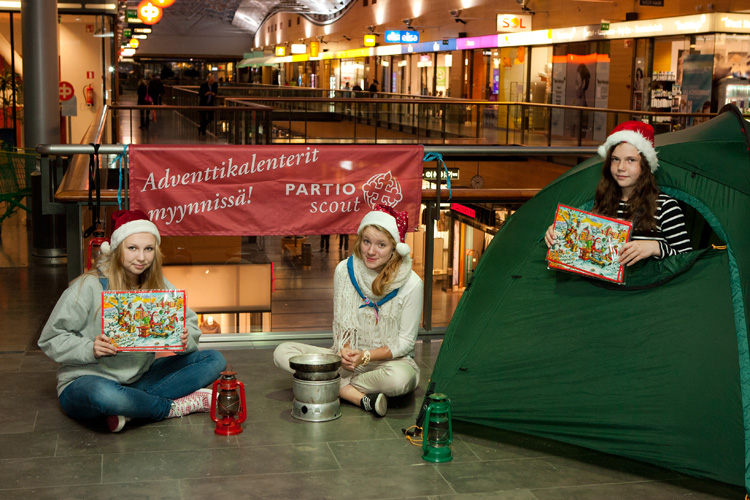 Many K-stores have a tradition to offer scouts a point of sale in front of the store. In this picture, scouts are selling calendars in the Iso Omena shopping centre in Espoo. Photo: The Guides and Scouts of Finland / Otso Nuotio.
Many K-stores have a tradition to offer scouts a point of sale in front of the store. In this picture, scouts are selling calendars in the Iso Omena shopping centre in Espoo. Photo: The Guides and Scouts of Finland / Otso Nuotio.
And there are not many Finns either who would say ’no’ to a cub scout. The Guides and Scouts of Finland have been selling the advent calendar every year since 1947, and for many of us, Christmas would not be the same without it. In fact, the calendar has gained popularity, proof of which the record number of calendars sold last year. The traditional favourite lives with the time: the completely Finnish made advent calendar, carrying the Key Flag symbol, can now be purchased online for the first time (www.adventtikalenteri.fi). Why not send it to your stakeholders as a Christmas greeting for example.

The advent calendar is a much loved herald of Christmas, but also a very important fundraising tool. Guiding and scouting is almost entirely based on volunteer work, but it would not be possible without any money. The groups need a place, a hut, for their weekly meetings, it is impossible to organise camps and adventures without tents and cookers, and boats need regular maintenance. Larger camps and trips abroad are often so expensive that the common funds are used to enable participation.
Even more important are the activities taking place at excursions, camps and huts. Children and youths are always given the opportunity to take responsibility and grow with the challenge – in group leadership, arranging an activity, or finding the next orienteering control point. They are allowed to mess up, succeed, get excited and change direction with adult back up always available, but without interfering. The young can take lead and make decisions – even if it goes wrong sometimes. And when young people are trusted, they become confident with their skills and trust other people.
Such youths will become adults who know how to take responsibility for issues of common concern and also want to do it. Seven euros is a small price for it.
Anna Munsterhjelm is the President of the Guides and Scouts of Finland (Suomen Partiolaiset – Finlands Scouter ry), Finland’s largest youth organization. Every year, it offers new experiences and adventures to some 65,000 children and youths, and teaches them skills ranging from leadership to outdoor pursuits and from group work to international contacts. For adults, guiding and scouting provides meaningful voluntary work.
Photo of Anna Munsterhjelm: The Guides and Scouts of Finland.
Kesko participates in several projects that promote wellbeing and physical activity among young people. The Guides and Scouts of Finland is one of Kesko’s long-term partners. For several years, guides and scouts have sold their advent calendar at K-stores too, raising funds for their operations that promote leisure activities for young people.
Kati Malmelin: Joint efforts to improve our planet
Our wellbeing depends on the food, water and energy provided by nature. We don’t have a shortage of essential natural resources in Finland, but our ecological footprint is large.
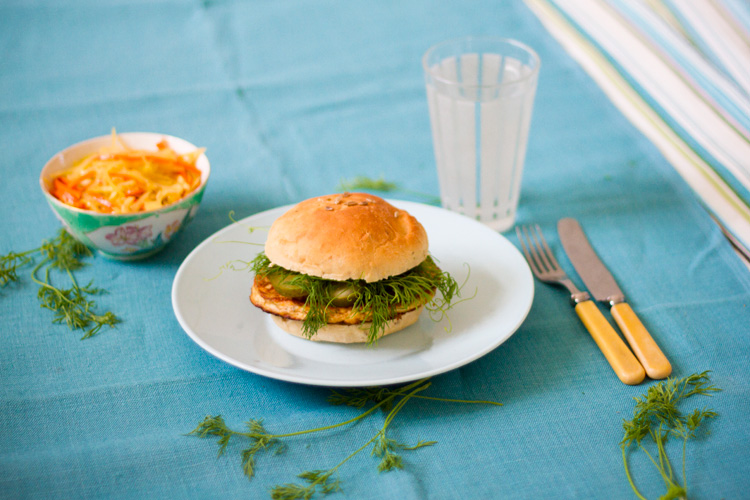 Photo: © Pauliina Heinänen / WWF
Photo: © Pauliina Heinänen / WWF
It is easy to decrease your ecological footprint by paying attention to what you eat. Food accounts for about 20% of the carbon dioxide emissions caused by humans. In Finland, people complain about the price of food but at the same time throw away 20–30 kilos of edible food per person each year.
Each of us can contribute to the responsibility of their own food choices by following WWF guidelines, which are ultimately quite simple: replace some of the meat with vegetables and sustainable fish, don’t throw food away and favour responsibly produced food.
How to make the change?
Eva Heiskanen, Research Director of the National Consumer Research Centre, has said that the five issues that affect a sustainable way of life are awareness, other people, habits, supply and the operating environment.
During the current flood of information, we have no shortage of knowledge. But how is it with the other issues? Do I change if no one else in my circle of acquaintances seems interested? Or how do I change if there are no responsible options available in the way that is suitable for me?
Retail trade has a significant role to play in the development of the responsibility of food consumption. The supply of responsible fish and, say, of Fairtrade products, has already increased. WWF hopes that this development will continue and strengthen.
Let’s succeed together
The trading sector also has a particularly large impact on how people’s consumption habits change and how we can promote this change together. For example, the increasingly innovative social media services available for us create interesting opportunities to enhance general interest in responsible practices, for peer communications and social learning.
Kesko’s grocery trade and media house Aller recently announced that they are establishing a joint impressive food media aiming to become the sector leader in Finland. It is interesting to see how this service will encourage Finnish people to make delicious everyday food choices that are also responsible from the viewpoint of the environment. At the same time, any possible prejudices concerning the price or delicious taste of responsible food can also be removed.
Read more about work by WWF Finland: http://wwf.fi/en/
Photo of Kati Malmelin: © Aki-Pekka Sinikoski / WWF
Writer: Kati Malmelin, Director, Corporate Relations, WWF Finland
Leila Räsänen: Biodiversity – experiences to suit all tastes
What was the favourite holiday location for you and your family last summer? Did you enjoy the summer on a lush island, barren fells, or splashing around on the waterfront, or in the shade of the forest at the summer cottage?
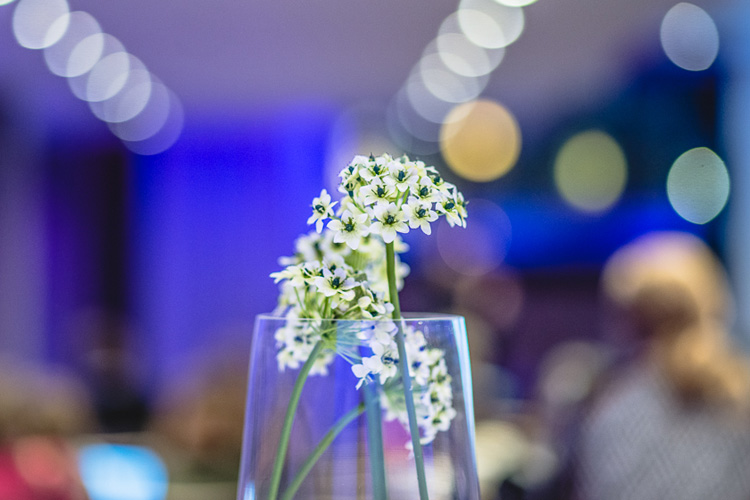
Biodiversity refers to the variety of life, which provides us with aesthetic and inspiring holiday experiences – the archipelago, fells, hot sandy beaches and spruce forests are all different natural environments. Biodiversity refers to the variety within and between species manifested in different habitats which range from the barren tundra to the Amazonian rain forests.
Besides the aesthetic aspects, biodiversity maintains functions that are necessary for the wellbeing of mankind. These ecosystem services are grouped into provisioning, regulating, supporting and cultural categories.
Recreation in a national park is an example of cultural services – the landscape provides inspiration to visitors and tourism provides a livelihood to local entrepreneurs.
Nature provides us with medicinal herbs, mushrooms, berries and game. In addition, forest owners sell timber for livelihood needs. The capacity of an ecosystem to provide goods and services for our needs is called provisioning service.
The supporting and regulating services provided by habitats sequester carbon in wood, maintain fresh groundwater and protect from floods, for example – a manipulated environment may deteriorate biodiversity whereby its natural capacity to retain and purify water is jeopardized.
Humankind is the key in the preservation of biodiversity and efficient ecosystem services. Natural resources are hard-pressed because of the increasing human population and commercial activities, as a result of which our rich natural environment suffers, floods occur and pollination services, important to food production, decline significantly.
Businesses are encouraged to reflect on the connection between their operations and biodiversity. It will help them map the risks and opportunities related to their business, as well as safeguard their operating conditions for the coming years – the availability of cocoa, for example, will be at stake in the future.
In our role as consumers, we should make considered purchases, avoid food waste and choose environmentally friendlier alternatives whenever possible – the choice can be a more sustainably caught, MSC certified fish product, or PEFC or FSC certified printed product or a garden furniture set.
The writer is CR Specialist at FIBS CR Network.
Further information: http://www.fibsry.fi/fi/english/home
Kari Herlevi: Circular economy is changing consumers and retailing
A circular economy has arrived to Finland at a fast pace over the past year. A circular economy is one of the Finnish government’s spearhead projects and the companies’ willingness to adopt new ways of doing business speeds up the change. But what actually is a circular economy and how does it concern each of us?
What is a circular economy?
Population growth and ever-scarcer natural resources will increase the prices and decrease the availability of raw materials in the future. A circular economy helps Finland to prepare for this development.
A circular economy refers to a well-planned economy where wastage of materials and generation of waste are minimised. The use of resources and materials becomes more efficient so that raw materials stay in circulation and retain their value better than before. In practice this can, for example, mean that sorting and recyclability of materials is ensured in the product design.
Circular economy involves great potential
In a circular economy, more valuable potential than material flows or waste is provided by the maintenance, reuse and remanufacture of equipment. That is, the question is not about recycling which aims to find new uses for waste. According to Sitra surveys, increasing efficiency in the circulation of resources will provide an annual growth potential of at least three billion euros to the Finnish economy by 2030.
Consumers accelerate the change?
In a circular economy, new kinds of services will increase the value of materials. The emphasis in consumption is increasingly shifting to services. People don’t need most items so often that they should own them, which also involves looking after their storage and maintenance. In leasing services, products are returned to the lease provider and the parts that wear out or become technically obsolete fast can be replaced with new ones.
Consumers can shift to a circular economy for instance by recycling the unused items they have in stock, increasing the amount of vegetables in their diet and reducing food wastage. Households are responsible for most of the food waste, which is about double the amount discarded by retail stores.
Retail trade knows how to minimise food waste
Annually, retail stores account for about 65–76 million kilos, that is 4-5% of all food waste. Food removed from sale can now also be donated to charity in Finland. In Helsinki metropolitan area, bread waste is used by the ST1 bioethanol plant.
Key means of minimising food wastage of retail stores include an efficient forecast and order process, as well as logistics, limited product displays, price reductions of outdating products and competent staff. Reducing wastage generates significant savings to large retailers.
A profit-seeking social supermarket will be opened in Sweden this autumn. It will sell slightly damaged fruit and vegetables, and groceries that have recently passed or are just passing their best-before dates.
Kari Herlevi is Senior Lead, circular economy at Sitra, the Finnish Innovation Fund. Sitra’s aim is to establish a common desire across Finland to shift to a circular economy. Sitra’s actions underway comprise, for example, the textiles sector, circulation of nutrients, and technology and export intensive firms.
Sirpa Juutinen: Ensure at least these five corporate responsibility issues
What are the five issues against which to assess the state of responsibility in a company? What things make us conclude that this area is under control and results can be expected?
1. Active interaction with many kinds of stakeholders
The basis of everything is to understand the expectations and business pressures that come through different stakeholder groups. I will probably always remember the lecture given by a US professor in the early 2000s in which he said:”You have to listen to your stakeholders, even aliens”. Stakeholders are both a mirror of today and also reflect weak signals.
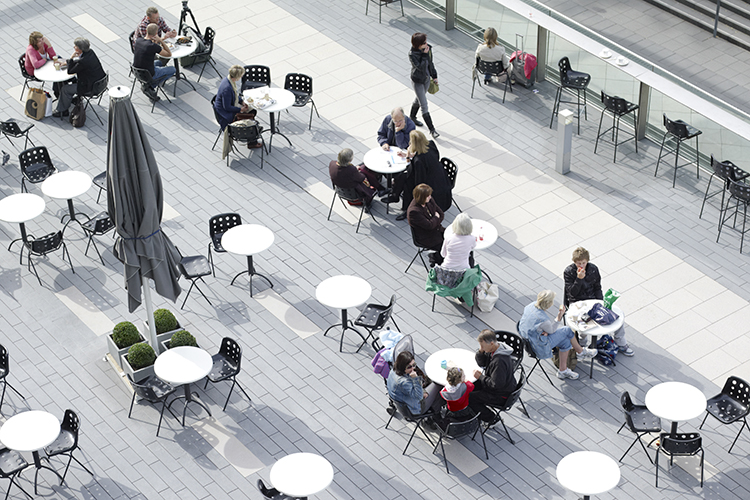
2. Material parts have been picked out from the large whole
Corporate responsibility is a vague and unclear term, which needs to be concretised. This is achieved by assessing what is material. My rule of thumb has been that the number of material aspects should rather be closer to ten than over twenty. The purpose is to put them under strong and target oriented management, which cannot be done with a very large number of issues are the same time.
3. The significance and impact mechanisms of responsibility as a creator of business value has become clearer
This thought exercise should be done when defining materiality so as to clarify the significance of responsibility in the company’s value creation. Some of the issues have a direct impact on it, while some impact through some other, and they are by no means the only factors that affect the value. But they are involved, anyway, and the impact mechanisms should be known.
4. Corporate responsibility issues are actively managed and included in the management system
Results are achieved in responsibility issues in the same way as in other issues: they have to be managed actively, which means clear objective setting, measurement and monitoring as well as giving rewards when there is reason to. Objectives are not only set for the head of corporate responsibility but for everyone whose area of responsibility the achievement of the objective concerns.
5. Results are reported and communicated on a regular basis
Openness and transparency that are an important part of corporate responsibility are promoted by regular reporting of results achieved. However, this alone is not sufficient for communicating about corporate responsibility. Various stakeholders expect different information and they are reached through different channels. Neither should we forget investor communications in the world where responsibility has increasingly become a part of investment policy in the form of ESG criteria.
The company that has these five issues in order has made good progress in corporate responsibility. So you should keep an eye on them.
Sirpa Juutinen, Partner, Corporate Responsibility Services, PwC
Tapio Hakaste: Salmon!
It provides experiences and bread in different ways. It provokes opinions: Are they many or few, who are allowed to fish them and how to turn them into delicious food.

From time to time, discussion on salmon has been heated in Finland, incuding the Finnish Parliament. The salmon and sea trout strategy was completed in autumn 2014. It was prepared by a large group of stakeholders – from north to south, from professional fishers to tourism entrepreneurs.
The strategy aims at well and healthy salmon and sea trout stocks by 2020. The objective is to provide healthy lifestyle and experiences with salmon fishing for many Finns as well as sustainably caught domestic salmon to food stores for happy consumers to buy. From the early stages, it became evident that sea trout - ”salmon’s little brother” - should also be included in the process.
The strategy was drawn up as a result of team work and comprises measures considered important and supported by various parties. In most cases, comments on the finished strategy were that a good compromise had been reached in a difficult issue. Still, there are lots of varied views and opinions when salmon is concerned.
A central issue is sustainable fishing. Salmon and sea trout must be caught in such a way that a sufficient number of female fish find their way to their home rivers to breed. For this purpose, objectives have been set for the number of female salmon and sea trout. As far as salmon is concerned, the trend has been distinctly positive; in the Tornionjoki and Muonionjoki Rivers, for example, the situation looks excellent. Instead, the fishing of sea trout should be reduced.
The salmon strategy has been published on the website of the Ministry of Agriculture and Forestry. The strategy provides the basis for Finnish stands and opinions in our international cooperation. The new Fishing Act that will come into force at the beginning of 2016 and the Fishing Decree to be amended are important tools in the implementation of the strategy. The strategy includes a number of measures, presenting a major challenge but the work is well underway. A monitoring group has also been set up to follow the implementation of the fish passage strategy.
Have a delicious summer with salmon!
Tapio Hakaste
Secretary to the monitoring group
Ministry of Agriculture and Forestry
Sanna Räsänen: Consumers choose easily available, high-quality ethical products
Sales of Fairtrade products increase year by year and
Finnish consumers’ interest in ethically grown and manufactured products keeps
growing. Still, this does not mean that the Fairtrade label on a product
package alone would guarantee success in sales. What we need are easily
available and high-quality ethical products before we can expect them end up in
shopping trolleys throughout Finland.
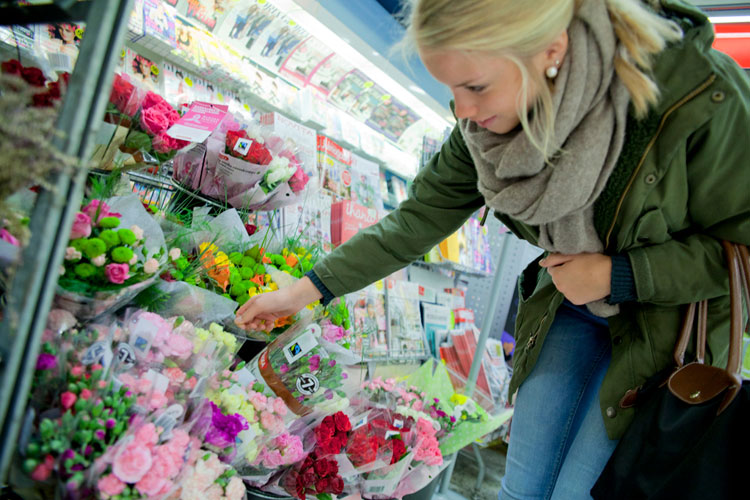
Pirkka roses and carnations serve as good examples of widely available high-quality Fairtrade products. Kesko Food included Fairtrade roses in its selection in 2006 and their sales have been continuously growing. Flower bouquets are so easily accessible in grocery stores that buying them has become an everyday activity. Consumers no longer need a special day to buy cut flowers for home. Flowers are bought in such quantities that their prices are tempting and flower farm employees benefit in the terms of higher wages and increasing Fairtrade premiums.
It should go without saying that human rights belong to all farmers in developing countries – but this is not yet the case
There are still many products from developing countries on sale in Finland the origin of which does not bear close scrutiny. We buy fruits, the growers of which are paid so little that they do not get enough to feed their families. When making purchasing decisions, we think about our health but may choose fruits that have been grown with chemicals that are harmful to the environment, and the workers handling them may not have sufficient respiratory protection. Fortunately, awareness of these issues is increasing and consumers have learned to look for the Fairtrade label on product packages and stickers.
Ethical choices benefit everybody
If Fairtrade products are not available on store shelves or customers have to kneel down to the floor level or reach on a two-metre shelf to get them, an ethical choice may often not be a real option.
So it is for the benefit of both consumers, retailers, manufacturers and, above all, Fairtrade farmers that plenty of high-quality Fairtrade products end up on store shelves: full-bodied coffee, sweet bananas, delicious chocolate and long-lasting flowers.
Sanna Räsänen
Communications Officer, Fairtrade Finland
Lasse Aho: From a campaign towards a permanent and sustainable change in attitudes
A well-known Finnish statesman once said: ”Acknowledging facts is the basis of all wisdom”. We have gradually and almost unnoticed drifted into the situation where, year by year, the proportion of products manufactured in Finland has decreased and they play a smaller role in consumers’ purchasing behaviour, including their daily purchasing decisions. An acknowledged fact is that the change has a clear and direct correlation to Finnish companies’ ability to employ and compete.
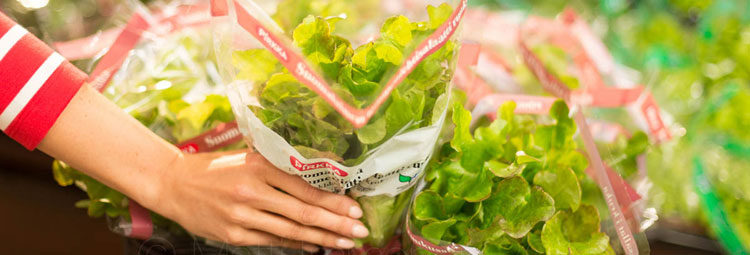
There is a general awareness of how serious the situation and development are. A fine proof of this is the Blue and White Footprint campaign, created as a result of cooperation between Kesko and the Association for Finnish Work. It is not only a terrific and concrete way of highlighting quality products manufactured in Finland, but also a determined, brave and far-reaching approach with a message in favour of Finnish origins. When successful, the campaign will have social significance.
Attitudes change slowly. These times provide excellent circumstances for a change which will bear fruit in the far future. In the future, where an increasing number of consumers, more and more families, young and old, see it as a matter of honour to primarily choose products made in Finland. They decide on a Finnish product whenever possible.
Now it is high time – ”the eleventh hour” – to raise the role of products made in Finland to the level they deserve. The target is to address and challenge Finnish consumers to choose a domestic product when making a purchasing decision.
The Blue and White Footprint campaign presents a challenge for all of the parties. Its implementation requires patience and persistence, brave communications and practical work.
The best merchandise must be selected for the campaign, as the quality will best take the message forward. Consumers are educated and critical, but also increasingly aware of the importance of Finnish origins. In order to counterbalance global and European influence, we need a stronger domestic manufacturing industry, stronger Finnish brands and more Finnish ownership.
It is great that the best Finnish brands and companies participate in the campaign on a wide scale, covering many categories and sectors. We share the same concern and the same targets – building an increasingly blue and white Finnish society, maintaining and improving our national competitiveness and being able to employ higher numbers of Finnish people in Finland. This work must not be left unfinished.
I want to thank all of the companies and communities that participate in the Blue and White Footprint campaign and project. This issue is important! The campaign promoting Finnish work is not insignificant but of primary importance. All of us have a major role to play in it and much opportunity to make an impact. I believe strongly that today’s consumers and particularly future consumers will reward this important work in the form of higher purchases and thus a higher level of well-being.
Lasse Aho
Managing Director
Olvi plc
Sari Kuvaja: Value of dialogue
In 1997, when I set up my business I had a dream and my business had a goal: I wanted representatives of NGOs to be elected members of company boards. At that time, the relationships between NGOs and businesses were more or less distrustful and characterised by suspicion and a lack of confidence. Dialogue was conducted through the tabloids – there was no internet or social media yet.
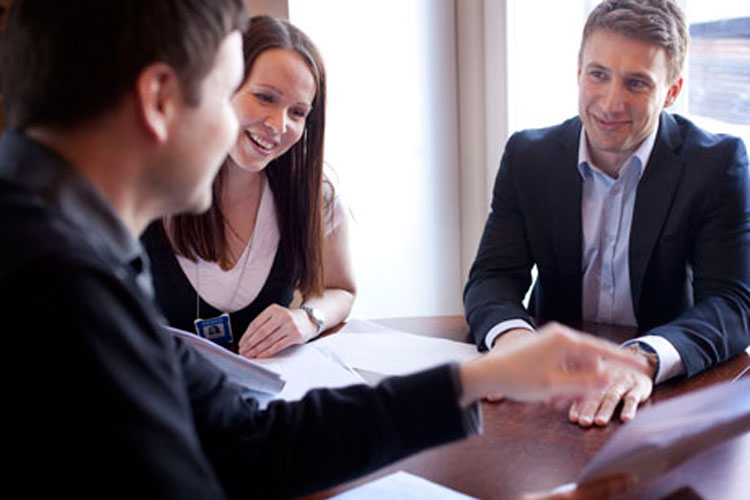
In my opinion, having representatives of NGOs as board members would be an indication of the kind of broadmindedness and courage which I expected and hoped of businesses. It would prove that the credibility and professionalism of NGOs has strengthened. I thought that cooperation would help business managements see the seriousness of the ecological crisis and challenge them to develop business operations that would be in compliance with genuinely sustainable development.
Today, almost 20 years later, lots of companies maintain regular contacts with civil society representatives. Stakeholder dialogue has become part of corporate responsibility and communications. G4, the latest Sustainability Reporting Guidelines of the Global Reporting Initiative, increasingly highlights the role of stakeholder dialogue in determining the issues material to corporate responsibility. Has dialogue become a value in itself? Has it become something a self-respecting, modern company has to do, in one form or another?
In my opinion, openness is a value in itself, whereas stakeholder dialogue is, first and foremost, a tool. Engaging in dialogue just for the fun of it is of no use. The more diversified, regular and deeper it becomes the more resources it will require. Perhaps that is the reason why many companies use web-based services and questionnaires to survey stakeholder views. But sometimes an in-depth interview of a few key customers or personal discussions with NGO representatives may be more enlightening.
Nevertheless, a company will not get the most out of dialogue unless its management realises and identifies the significance of engaging in dialogue with people and groups who have different values. To shake and be shaken.
Sari Kuvaja
Corporate Responsibility & Communications Specialist
Mira Jarkko: The Climate Partners network is searching for new ways to mitigate climate change
When I started my environmental studies at the University of Helsinki 25 years ago, I felt quite sure that I had come to the right place. On the very first day, we were told that we will become some kind of interpreters, building bridges between the representatives of different disciplines. It was important for us to learn to understand different approaches and perspectives to environmental issues and also apply criticism. Environmental problems cannot be solved with science only.
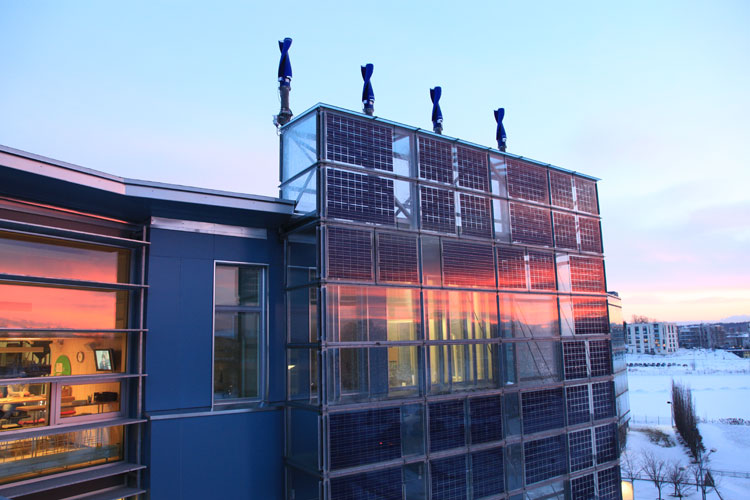 The Viikki environmental house is the most energy efficient office building in Finland. We started storing solar energy last summer and have been using it to recharge an electric car. The experiment was developed in cooperation with Climate Partners.
The Viikki environmental house is the most energy efficient office building in Finland. We started storing solar energy last summer and have been using it to recharge an electric car. The experiment was developed in cooperation with Climate Partners.
Climate change affects everybody
Now, 25 years later, my job is to coordinate Climate Partners, the cooperation network of the City of Helsinki and businesses, joined by 45 members during the past two years. The network comprises big and medium-sized companies of various sectors, universities and research institutes and, naturally, the City of Helsinki. Together with Helsinki Mayor Jussi Pajunen, all of them have signed their own commitments for the mitigation of climate change. In addition to the commitments, the network aims to conduct joint concrete experiments and projects to mitigate climate change. I feel very much at home in this network.
Today, cooperation between different sectors to curb or adapt to climate change goes without saying, or at least it should. Climate change has an increasing impact on business prerequisites. Investors’ belief in the profitability of fossil fuels is decreasing. Consumers vote with their purchasing decisions. Many of us ordinary people have a pang of conscience when passing shelves of organic meat when we know that domestic organic production should be supported. On the next payday, I promise myself – the price does matter.
Big changes are created together
No actions by individuals, businesses and the city alone are sufficient to mitigate climate change. What we need are major, system-level changes in construction, traffic and energy production. Big changes come from socio-technical innovations, a combination of innovations that affect technology, behaviour and business models. In a low-carbon society, energy efficiency, the wellbeing of people, and economic resilience go in the same direction.
The best things arise from cooperation between different people and operators. The Climate Partners network aims to contribute to the generation of these best things.
Experiments made in the actual environment are the best method
New system-level innovations are difficult to test in a lab environment. A city is an excellent testing environment and platform, and successful tests have already been carried out in the new Kalasatama area and the Viikki environmental house in Helsinki. The smart container experiment in Kalasatama presented an easy way to provide inhabitants with services not yet otherwise available. In Viikki, storage of solar energy and the opportunities it opens up are tested.
Challenges may occasionally arise from the slow decision-making process of the city (which may sometimes be called democracy or consideration) and the quarterly approach by businesses. It takes a lot of courage from an ordinary official to try a completely new solution with taxpayers’ money.
"What if it fails? Where to find money to make corrections? How many times would you like to go the city council to explain an unsuccessful trial?” asks Deputy Mayor Pekka Sauri, but continues by saying that this is something we should do to make big changes possible.
The atmosphere encouraging to experiments should and could to be extended beyond terms in office and quarterly reports. Committing businesses and universities to solve social problems could be the model that, over a long term, would generate new, globally distributable business models. The risks involved in the experimental culture also mean great opportunities for all.
 A convenient journey from Pasila to Climate Partners’ seminar at City Hall was by bike.
A convenient journey from Pasila to Climate Partners’ seminar at City Hall was by bike.
Both side by side and together
Climate Partners are each committed to reducing their emissions. However, by themselves they can only reduce their emissions to the certain point but cooperation can take them further or faster. Someone’s waste is a valuable ingredient for someone else or a new service can be the missing piece that completes, say, a traffic solution with lower emissions. In the Climate Partners network, different sectors collide and make it possible to build a new low-carbon society. Let’s hope that we have enough courage to try things out!
Mira Jarkko Climate Partners network, Coordinator City of Helsinki Environmental Centre
The Nordic Ecolabel or the Swan label celebrates its 25th anniversary this year with the theme of ”Save a small piece of the world every day”. In a quarter of a century, the Swan label has become an esteemed, well-known and reliable ecolabel. The Swan label makes it easy for shoppers to make responsible decisions.
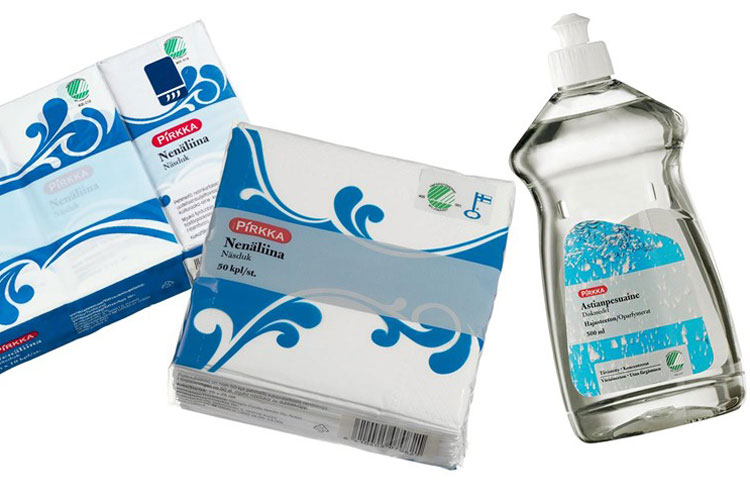
In Finland, the Swan label is carried by about 2,000 products and services, while the corresponding figure in the Nordic countries is about 19,000.
The Swan label can be found on many different products: toys, vehicle fuels, detergents, cleaning equipment, furniture, paints, etc. Services too, such as hotels, printers, cleaning services and car wash facilities, can carry the Swan label.
Swan-labelled Pirkka products
There are more than 80 Pirkka products with the Swan label. Customers can choose Swan-labelled Pirkka toilet and household paper, washing-up liquid, dishwasher detergent, laundry detergent, baking paper, napkins and candles.
In the production of Swan-labelled Pirkka handkerchiefs and toilet papers, for example, strict limits are set to energy consumption and all the raw materials used have been checked. Swan-labelled Pirkka detergents are energy-efficient and produce clean laundry at low temperatures. The Pirkka baking paper is fluoride-free and Swan-labelled Pirkka candles meet the strict requirements set for soot emissions and chemicals.
Life-cycle thinking on the background
When buying a Swan-labelled product or service, the consumer can be sure that it meets strict environmental criteria. Swan label criteria are based on the life-cycle thinking which means that the products’ ingredients, manufacture, use and disposal have all been taken into account. Requirements are also placed on the quality, health and safety.
The Swan label is only granted to the products and services that are best for the environment. The product or service has to meet the criteria set in order to get the Swan label. The criteria have been created for more than 60 product groups.
A company applies for the Swan label for its product or service with a written application which also indicates that the relevant criteria are met. In addition, a representative of the Swan label will carry out a monitoring visit in the company. The Swan label is granted for a fixed period as the criteria are modified every 3 to 5 years on average.
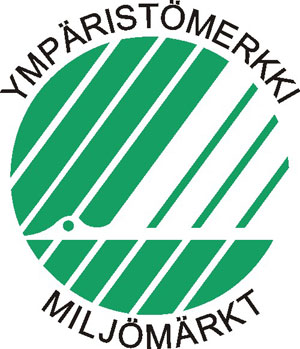
An esteemed brand
The Swan label’s last year was crowned by being ranked number five on the list of the most esteemed brands in Finland – from among more than a thousand well-known brands!
This provides a good start for the anniversary year: the 25th anniversary celebration of the Swan label will be held on the Mediatori square in Sanomatalo in Helsinki on 1-3 October – Pirkka products will also be there. Welcome to join us!
The author is Minna Kinnari, communications specialist for the Swan label.
